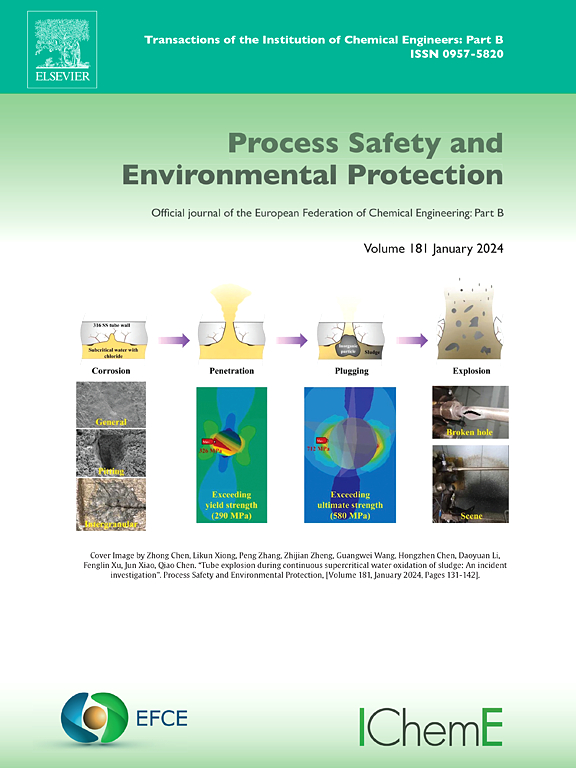熟料/Ca(OH)2外掺对油页岩灰分- mswi FA基胶凝材料水化机理的影响
IF 6.9
2区 环境科学与生态学
Q1 ENGINEERING, CHEMICAL
引用次数: 0
摘要
本文以高炉矿渣(BFS:70 %)-生活垃圾焚烧粉煤灰(MSWI FA:20 %)-脱硫石膏(DFG:10 %)胶凝体系为基础,以油页岩灰分逐步取代BFS制备固体垃圾第四系胶凝体系。选择最佳配比后,以PI 42.5和Ca(OH) 2为活化剂进行优化,研究不同活化剂类型和用量对固废胶凝体系的影响。结果表明,PI 42.5显著提高了固废基系统的强度。熟料的最佳效果在水化后期前移。CP1的强度达到39.06 MPa,提高了50% %。Ca(OH) 2在早期形成了许多六方片状晶体,降低了体系的早期强度,但在后期水化阶段显著提高了体系的强度。各组重金属浸出结果均达到饮用水水质标准。XRD、FTIR、TG-DTG、sem & EDS等微量分析表明,PI 42.5的加入促进了钙矾石、C - (A) - s - h和水合氯铝酸钙(HCC)等功能水化产物的生成。随着水化反应的进行,钙矾石产量增加,C-S-H不断转化为C-A-S-H, CP1组在后期效果最好。该研究为城市危险废物与冶金固体废物协同利用提供了新思路,有利于经济与环境的协调,并为固体废物胶凝材料的优化提供了理论依据。本文章由计算机程序翻译,如有差异,请以英文原文为准。
Effect of clinker/Ca(OH)2 external blending on the hydration mechanism of oil shale ash–MSWI FA based cementitious materials
This paper utilized the blast furnace slag (BFS:70 %)–municipal solid waste incineration fly ash (MSWI FA:20 %)–desulfurization gypsum (DFG:10 %) cementitious system as a foundation, with the oil shale ash gradually replacing the BFS to prepare a solid waste quaternary cementitious system. After selecting the optimal ratio, PI 42.5 and Ca(OH)₂ are used as activators to optimize it, and the impact of different activator types and dosages on solid waste gelling systems is studied. The results show PI 42.5 markedly enhances the solid waste-based system's strength. The optimal effect of clinker shifts forward in the later stage of hydration. The strength of CP1 reaches 39.06 MPa, with a 50 % improvement. Ca(OH)₂ led to the formation of many hexagonal plate-like crystals at the early stage, reducing the system's early strength but significantly increasing it at the later hydration stage. The heavy metal leaching results of all groups meet the drinking water quality standard. Microanalysis by XRD, FTIR, TG-DTG, SEM&EDS shows that the addition of PI 42.5 promotes the generation of functional hydration products such as ettringite, C–(A)–S–H and hydrate calcium chloroaluminate (HCC). As the hydration reaction progressed, ettringite production rose, C–S–H converted to C–A–S–H continuously, and the CP1 group has the best effect in the late stage. This study provides new ideas for the synergistic utilization of municipal hazardous wastes and metallurgical solid wastes, aids economy-environment coordination, and provides a theoretical basis for optimizing solid-waste gelling materials.
求助全文
通过发布文献求助,成功后即可免费获取论文全文。
去求助
来源期刊

Process Safety and Environmental Protection
环境科学-工程:化工
CiteScore
11.40
自引率
15.40%
发文量
929
审稿时长
8.0 months
期刊介绍:
The Process Safety and Environmental Protection (PSEP) journal is a leading international publication that focuses on the publication of high-quality, original research papers in the field of engineering, specifically those related to the safety of industrial processes and environmental protection. The journal encourages submissions that present new developments in safety and environmental aspects, particularly those that show how research findings can be applied in process engineering design and practice.
PSEP is particularly interested in research that brings fresh perspectives to established engineering principles, identifies unsolved problems, or suggests directions for future research. The journal also values contributions that push the boundaries of traditional engineering and welcomes multidisciplinary papers.
PSEP's articles are abstracted and indexed by a range of databases and services, which helps to ensure that the journal's research is accessible and recognized in the academic and professional communities. These databases include ANTE, Chemical Abstracts, Chemical Hazards in Industry, Current Contents, Elsevier Engineering Information database, Pascal Francis, Web of Science, Scopus, Engineering Information Database EnCompass LIT (Elsevier), and INSPEC. This wide coverage facilitates the dissemination of the journal's content to a global audience interested in process safety and environmental engineering.
 求助内容:
求助内容: 应助结果提醒方式:
应助结果提醒方式:


